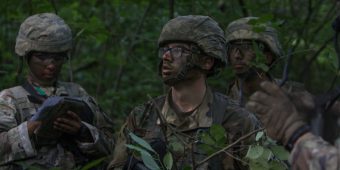Fourth Regiment, Advanced Camp, Cadets conducted an attack on a group of Opposing Force (OPFOR) at approximately 8:15 a.m. today.
“Today, they were focused on the first mission, which was an attack. An attack to defense,” Clarkson University Instructor, Master Sgt. James Prescott said.
The attack was the first lane 4th Regiment was scheduled to complete for the Field Training Exercise I (FTX I), but the lane did not go as planned. The Cadets ended up defending their position after an ambush from the OPFOR team.

Cadets from 4th Regiment, Advanced Camp, meet and communicate information about the lane they are completing, while they act as squad leaders during their Field Training Exercise (FTX) on June 30 at Fort Knox, Kentucky. The FTX places Cadets in high-stress, mock-combat environments to see how they perform and lead under pressure. | Photo by Reagan Zimmerman, CST Public Affairs Office
Trouble stirred when information was not communicated correctly and the platoon got off track. Despite this hiccup, the lane was not a failure.
“It was good that they got this initial run to shake the cobwebs off and it gave them [the idea] of this is what we need to do, and the mentality they need to be in for the way forward through the FTX,” Prescott said.
Cadets are taken through three phases of the FTX. Wolverine is the “crawl” phase of the “crawl, walk, run” phases during the FTX. At Wolverine, Cadets are trained by Cadre on how to conduct platoon level attacks, assaults, defenses and movements to contact. Panther is the “walk” phase where they are no longer Cadre led and Cadets begin to be assessed on their missions. Grizzly is the final “run” stage where they are completely Cadet led and their final evaluations are made.

A Cadet from 4th Regiment, Advanced Camp, pulls security during the Field Training Exercise (FTX) on June 30 at Fort Knox, Kentucky. The FTX places Cadets in high-stress, mock-combat environments to see how they perform and lead under pressure. | Photo by Reagan Zimmerman, CST Public Affairs Office
Moving forward, the Cadets are looking to learn from their mistakes as they enter the “walk” phase of their FTX.
“The Cadre are here but they are not necessarily holding our hand every step of the way,” Cadet Samantha Hawkins, from Columbus, Ohio, and attending the Ohio State University, said. “It really gave everyone a chance to get out of their comfort zone and start to make decisions, even if they weren’t necessarily the right decisions.”
Though they are here to be graded, Hawkins believes the failures help with the training.
“It’s Cadet Summer Training, it’s not Cadet Summer Failures,” Hawkins said.
Cadet Erin Lingle, from Andalusia, Illinois, and attending University of Iowa, agreed with Hawkins about the benefit of mistakes.
“It is really good to see other people fail because you can place their failures in your position and learn from it,” Lingle said.

Cadet Cameron Heriot, from the University of North Georgia, studies his map after completing a lane during a Field Training Exercise (FTX) on June 30 at Fort Knox, Kentucky. The FTX places Cadets in high-stress, mock-combat environments to see how they perform and lead under pressure. | Photo by Reagan Zimmerman, CST Public Affairs Office
Cadets are taking baby steps toward the common goal of Cadet Summer Training; becoming strong leaders.
At the FTX, they are not just focusing on tactical leadership but leadership as a whole.
“While they judge us on infantry tactics, this is essentially leadership,” University of North Florida Cadet, Luis Verdiales, from Port Orange, Florida, said. “You can still use these traits in any part of the Army.”




